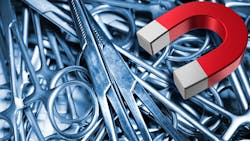Q: “Can you explain why surgical instruments get magnetized? We seem to be having more lately. What might be the best way to detect them and demagnetize them once found?”
A:
Let me simplify these questions:
1. Why do our instruments become magnetized?
2. What can we do about it?
This reminds me of the time when I was called into an operating room because a paper clip was found in a sterilized tray. I told the surgeon I would take care of the issue. More on that later.
Reducing incidence of surgical instruments from becoming magnetized and detecting magnetized instruments before use in surgery is part of any department’s Quality Management System (QMS) for inspection of medical devices.
Remember our mantra: “Clean and functional.”
1. Why do our instruments become magnetized?
What is magnetism?
Magnetism is an invisible force that can be produced by magnets, friction, or electrical currents that can be exerted onto specific metals and alloys given the proper conditions. Thus, medical devices like surgical instruments made of a combination of (ferrous) metals such as iron, cobalt, nickel, and other materials get magnetized often.
- Some delicate microsurgical and ophthalmic instruments become magnetized over a period due to simple friction (i.e., contact between instruments/rubbing against each other).
- Some facilities use magnetic mats to hold instruments in place during surgery.
- Not segregating instruments by metal types during the cleaning and the sterilization process can cause instruments to become magnetized.
Detecting magnetized instruments during the assembly process is a vital step in staff and patient safety.
- Tagging: If a medical device is found to be magnetized in the decontamination area, like a needle holder that has a needle already staying on it because it is magnetized, you can use a special tag that says “Magnetized” to identify and alert staff on the assembly side to remove the needle to the appropriate container and have the device demagnetized. The Operating Room might also tag instruments that are magnetized during surgery.
- Separation: Preventing magnetization requires segregation by type of metal (ferrous and non-ferrous) in the cleaning and sterilization process of these instruments. Use separate wrapping or containers and inserts to separate the instruments so they do not become magnetized.
- Method: Have a proven method for detection before anything is placed in a tray or individually peel pouched or wrapped.
How can I detect if an instrument is magnetized?
While magnetic fields cannot be seen, they can be detected by observing their effect on ferrous materials (e.g., paper clip/needle), causing them to move toward a magnetized medical device. If it does move, then the medical device will be removed from service.
Back to my story. Our process at the time was to use a paper clip to detect if an instrument was magnetized. The staff member simply forgot to take the instrument with the paper clip out of service. In my travels, I have seen some departments use a needle to detect if an instrument is magnetized.
2. What can we do about it?
How do I demagnetize my instruments?
If there is an instrument that is magnetized it must be demagnetized. Demagnetizers (also known as degaussers) are available.
- A degausser uses electromagnets to generate intense, high frequency alternating current (AC) magnetic fields.
- In response to AC magnetic fields, individual domains realign randomly, so their magnetic fields cancel (or nearly cancel), eliminating (or substantially reducing) undesired magnetism.
- After using a demagnetizer, use the same paper clip/needle test to ensure the device is no longer magnetized. If it still attracts, then demagnetize again until there is no attraction; then you can safely place the instrument in the tray set or individual package (i.e., peel pouch).
I am not saying to only use a paper clip or a needle. I have been told there are some other methods available for departments to use. Therefore, your department needs an approved process (as part of your QMS) to reduce the possibility of magnetized instruments showing up in the surgical field (as well as undesired paper clips or needles).
About the Author

Stephen M. Kovach
Stephen M Kovach, BS, CFER, started in the medical field in 1975 as a sterilization orderly and has worked in many positions within the Healthcare Industry. He presently is Clinical Educator Emeritus at Healthmark, A Getinge company.
